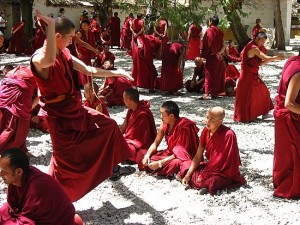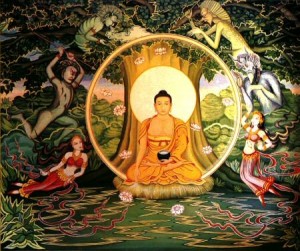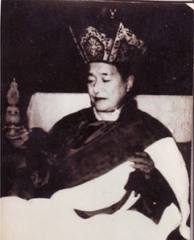
The following is respectfully quoted form “Treasury of Precious Qualities” a commentary on the root text of Jigme Lingpa by Lonchen Yeshe Dorje and Kangyur Rinpoche:
Analysis through the application of reason:
This method consists of four or five great arguments that establish the fact that phenomena are without inherent existence. The specific explanation of these arguments is preceded by a general exposition of how such assessments are made.
To begin with, the prasangika approach is unlike that of the Svatantrikas. Svatantrikas disprove true existence on the relative level but then assert an illusory existence. Likewise, they disprove conceptual construction on the absolute level, but then go on to assert (positively) that this absolute is beyond conceptual construction. The prasangika method is simply to demolish the defective propositions of their opponents by directly refuting every assertion to which the mind might cling. But they do not accompany this with any kind of independent pronouncement. In order to eliminate clinging to real existence, it is essential to eradicate the conceived object of such clinging. Therefore, as we have said before, it is necessary to analyze and achieve certainty about the true nature of the two selves which are the object of refutation. Otherwise it is like shooting arrows without seeing the target, and it is impossible to eliminate the assumption of the real existence of a self.
When one uses madhyamika arguments to search for the meaning of suchness, the idea that “the opponent is wrong” is enough to cause one to stray off the point. Therefore, from the outset, do not refute only the assertion of an opponent, but work to eradicate completely all the innate discursive thoughts in your own mind, which have been left unexamined from beginningless time and which deviate from the Truth of Suchness. Likewise, eradicate all clinging to positions or theories, which are imputations arising from philosophical inquiry and which are found in all tenet systems whether Buddhist or non-Buddhist. Subsequently, when you meditate, simply rest without clinging to anything, in the sense of having an object of meditation. This, however, is not to say that you should remain in a state of blankness, a “foolish meditation,” so to speak. On the contrary, through the certain knowledge deriving from the realization of the absence of inherent existence, your vipashyana will be rendered extraordinary and you will have no doubts. All this is the sign that your analysis has hit the mark.
Generally speaking, at the present time, all the great beings who uphold the Madhayamika declare that the way the phenomena of samsara or nirvana appear is as the mere imputation of thought; they are without dependent arising are indissociably united. Everyone is in agreement about this. In our tradition, however, we do not consider that the expression “imputed existence” implies the presence of a “something” that lacks true existence and to which true existence could be ascribed. We say that the object referred to is a kind of empty form, an originless display of the mind’s creative power.” Consequently, when emptiness is said to be inseparable from dependent arising, this is not meant to imply that there is a validly established appearance from which emptiness is inseparable. On the contrary, we understand that phenomena are themselves ungrounded and rootless. There is no way in which they could exist. And yet they arise freely, produced in interdependence.
Therefore, once the object of refutation, which is to be identified as the two really existing selves, has been eliminated, its place is not still occupied by some (residual) basis of refutation–a so–called person or phenomenon. There is simply nothing left at all. Persons and phenomena are empty of themselves. For one cannot say that they are empty of true existence while holding that phenomena themselves (the basis of emptiness) are not empty of themselves on the relative level. It is rather that form, for example, is empty of form and so forth. Therefore, because all phenomena are devoid of real existence, there is no “concrete” object of refutation. All that is refuted is the false imputation that ascribes existence to what does not exist. Nagarjuna says in his Vigrahavyavartant:
Since no object of negation can be found,
I myself have nothing to negate.
And so, by saying “I refute,”
You’re the ones who falsely testify.
It might be objected that there is a contradiction in saying, as we have just done, that the two selves are devoid of true existence, while at the same time affirming that persons and phenomena exist on the relative level. All we mean is that as long as there is the tendency to delusion, relative appearances arise constantly and unhindered. But this does not mean that they exist inherently.


